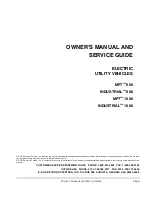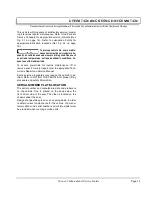
OPERATION AND SERVICE INFORMATION
Page 1
Owner’s Manual and Service Guide
Read all of manual to become thoroughly familiar with this vehicle. Pay particular attention to all Notes, Cautions and Warnings
Thank you for purchasing this vehicle. Before driving the
vehicle, we ask you to spend some time reading this
Owner’s Manual and Service Guide. This guide contains
the information that will assist you in maintaining this
highly reliable vehicle. Some illustrations may show
items that are optional for your vehicle. This guide covers
the operation of several vehicles; therefore, some picto-
rial views may not represent your vehicle. Physical differ-
ences in controls will be illustrated.
This vehicle has been designed and manufactured as a
‘World Vehicle’. Some countries have individual require-
ments to comply with their specifications; therefore,
some sections may not apply in your country.
Most of the service procedures in this guide can be
accomplished using common automotive hand tools.
Contact your service representative on servicing the
vehicle in accordance with the Periodic Service Sched-
ule.
Service Parts Manuals and Technician’s Repair and Ser-
vice Manuals are available from a local Distributor, an
authorized Branch or the Service Parts Department.
When ordering parts or requesting information for your
vehicle, provide vehicle model, serial number and manu-
facture date code.
BEFORE INITIAL USE
Read, understand and follow the safety label on the
instrument panel. Be sure you understand how to oper-
ate the vehicle, its equipment and how to use it safely.
Maintaining good performance depends to a large extent
on the operator.
Hydrogen gas is generat-
ed as a natural part of the
lead acid battery charg-
ing process. A 4% concentration of hydrogen gas is
explosive and could cause severe injury or death.
Charging must take place in an area that is adequate-
ly ventilated (minimum of 5 air exchanges per hour).
To reduce the chance of battery explosion that could
result in severe injury or death, never smoke around
or charge batteries in an area that has open flame or
electrical equipment that could cause an electrical
arc.
Hydrogen gas is generated in the charging cycle of bat-
teries and is explosive in concentrations as low as 4%.
Because hydrogen gas is lighter than air, it will collect in
the ceiling of buildings necessitating proper ventilation.
Five air exchanges per hour is considered the minimum
requirement.
Never charge a vehicle in an area that is subject to flame
or spark. Pay particular attention to natural gas or pro-
pane water heaters and furnaces.
Before a new vehicle is put into operation, the items
shown in the INITIAL SERVICE CHART must be per-
formed (Ref. Fig. 1 on page 1).
Vehicle batteries must be fully charged before initial use.
Check for correct tire inflation. See GENERAL SPECIFI-
CATIONS.
Determine and record braking distance required to stop
vehicle for future brake performance tests.
Remove the protective clear plastic, that protect the seat
bottom and back rest during shipping, before placing the
vehicle in service.
PORTABLE CHARGER INSTALLATION
To reduce the possibility
of overheating that may
cause serious damage to
the charger and create the potential for fire, do not
block or obstruct the airways. Portable chargers must
be mounted on a platform above the ground or in
such a manner as to permit the maximum air flow
underneath and around the charger.
Portable chargers are shipped with the vehicle. Prior to
vehicle or charger operation, chargers must be removed
and mounted on a platform or wall above the ground to
permit maximum air flow around and underneath the
charger. If the charger is operated in an outdoor location,
!
!
Fig. 1 Initial Service Chart
ITEM SERVICE
OPERATION
Batteries Charge
batteries
Seats
Remove protective plastic covering
Brakes
Check operation and adjust if necessary
Establish acceptable stopping distance (mechanical
brakes
only)
Check hydraulic brake fluid level if equipped
Tires
Check air pressure (see SPECIFICATIONS)
Portable
Remove from vehicle and properly mount
Charger
Ref Isc 5
!
!
Summary of Contents for INDUSTRIAL 1000 2004
Page 8: ...Page vi TABLE OF CONTENTS Owner s Manual and Service Guide...
Page 12: ...Owner s Manual and Service Guide SAFETY INFORMATION Page x Notes...
Page 43: ...Page 27 GENERAL SPECIFICATIONS Owner s Manual and Service Guide GENERAL SPECIFICATIONS...
Page 50: ...Page 34 Owner s Manual and Service Guide GENERAL SPECIFICATIONS Notes...
Page 51: ...Page 35 Owner s Manual and Service Guide WARRANTY LIMITED WARRANTIES...
Page 54: ...Page 38 Owner s Manual and Service Guide WARRANTY Notes...
Page 56: ...Page 40 Owner s Manual and Service Guide DECLARATION OF CONFORMITY...
Page 58: ...Page 42 Owner s Manual and Service Guide DECLARATION OF CONFORMITY Notes...
Page 59: ...Appendix A 1 LABELS AND PICTOGRAMS Owner s Manual and Service Guide LABELS AND PICTOGRAMS...
Page 72: ...Sivu vi SIS LLYSLUETTELO K ytt ja huolto ohje...
Page 76: ...K ytt ja huolto ohje TURVALLISUUSOHJEITA Sivu x Muistiinpanoja...
Page 107: ...Sivu 27 TEKNISET TIEDOT K ytt ja huolto ohje TEKNISET TIEDOT...
Page 114: ...Sivu 34 K ytt ja huolto ohje TEKNISET TIEDOT Muistiinpanoja...
Page 115: ...Sivu 35 K ytt ja huolto ohje TAKUU RAJOITETTU TAKUU...
Page 118: ...Sivu 38 K ytt ja huolto ohje TAKUU Muistiinpanoja...
Page 119: ...Sivu 39 K ytt ja huolto ohje YHDENMUKAISUUSJULISTUS YHDENMUKAISUUSJULISTUS VAIN EUROOPPA...
Page 120: ...Sivu 40 K ytt ja huolto ohje YHDENMUKAISUUSJULISTUS...
Page 121: ...Sivu 41 YHDENMUKAISUUSJULISTUS K ytt ja huolto ohje EI SAATAVILLA JULKAISUHETKELL...
Page 122: ...Sivu 42 K ytt ja huolto ohje YHDENMUKAISUUSJULISTUS Muistiinpanoja...
Page 123: ...Liite A 1 KILVET JA KUVAT K ytt ja huolto ohje KILVET JA KUVAT...











































